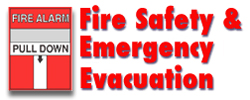Fire Safety & Emergency Evacuation

Important information
In the Event of a Fire
If you see smoke or flames... Use C.A.R.E.
Contain the fire by closing all doors as you leave.
Activate a fire alarm pull station. Pull stations are near exits from the building.
Report the fire by dialing 911 (DMS at Borwell dial 5555)
Evacuate or extinguish. It is best to leave the building using the nearest fire exit.
A fire extinguisher should only be used when you...
- You have been trained.
- You have the proper type and properly charged unit for the fire you are fighting.
- You have first contained the fire, activated the building alarm and have reported the fire.
- You have your back to an unobstructed exit.
- Everyone else has left the area.
- There is little smoke or flames.
Never fight a fire if it has left its source of origin, you are unsure of the type of extinguisher you are using or you lack a safe way to escape should your efforts fail. If the fire can not be brought under control in 30 seconds, then abandon your efforts, close the door(s) and evacuate immediately.
Evacuation
- In the event of a fire or fire alarm, supervisors must be sure that all employees evacuate the building and individuals who may need help are assisted to safety.
- Each office should develop an evacuation plan, which includes a primary and a secondary escape route.
- Establish a designated area to meet outside the building. This location should be known to everyone in your office and be far enough away from the building to ensure safety and avoid blocking access by emergency personnel.
- Your evacuation plan should also include a way to be certain that everyone has left or is otherwise accounted for when you leave the building.

Evacuation Tips
- You must leave the building immediately during an alarm.
- Do not "investigate" the source of a potential fire or hazardous material emergency.
- As you leave, close all doors behind you to limit the movement of smoke, flames or noxious odors.
- Walk-do not run-to the nearest exit out of the building.
- Do not re-enter the building for any reason once you have left.
- Gather at your designated area.
- Supervisors should account for everyone on their staff.
- Never use an elevator to exit a building during a fire alarm.
Fire Prevention

The best defense against fire is always prevention. There are a number of things you can do to help prevent fires. Here are just a few…..
- Limit the use of space heaters. Heaters must be UL rated and be equipped with a tip over switch. Plug space heaters directly into a wall outlet. Please contact EHS if you plan to use a space heater.
- Smoke only in designated areas. Be certain to properly extinguish all smoking materials.
- Keep all pathways clear. Do not block exits, fire extinguishers or sprinkler heads (18 inch clearance).
- Limit the use of extension cords and power strips. Never use an extension cord and a power strip together.
- Check electrical equipment at the end of the day to be sure it is shut off. Check items such as computers, coffeepots, copiers, fans and other electrical equipment.
- Check for frayed wires and missing grounding plugs on an on-going basis.
- Practice good housekeeping. Never store combustible material such as wood, paper and cardboard near sources of heat. Maintain a minimum distance of 3 feet.
- Equipment such as refrigerators, microwaves and copiers must be plugged into a wall outlet. Never use extension cords for these items.
- Store flammables in designated flammable cabinets. Some examples are aerosol cans, gasoline and oil-based paint. Contact EHS for assistance.
Training
- Fire extinguisher training is available from EHS. We invite department chairs, directors and supervisors to contact EHS to arrange training for your area(s).
- Training covers fire safety basics along with an emphasis on the types of fire extinguishers and their proper use. This training involves the "hands on" use of extinguishers with a controlled fire. Attendees will be qualified for the use of fire extinguishers for a period of one year.
- Fire extinguisher training is intended for those employees who may discover or respond to a fire. If you would like to schedule fire safety or fire extinguisher training, please contact EHS at 646-1762.
- Online Fire Extinguisher and Evacuation Retraining (online via Bioraft system)

Other Links




![]()

